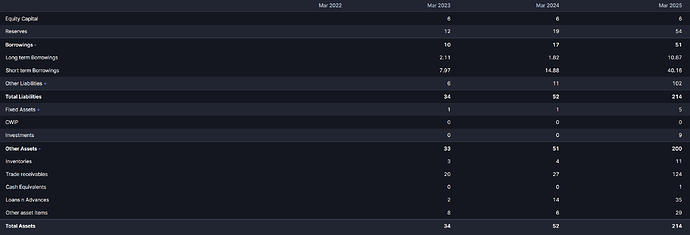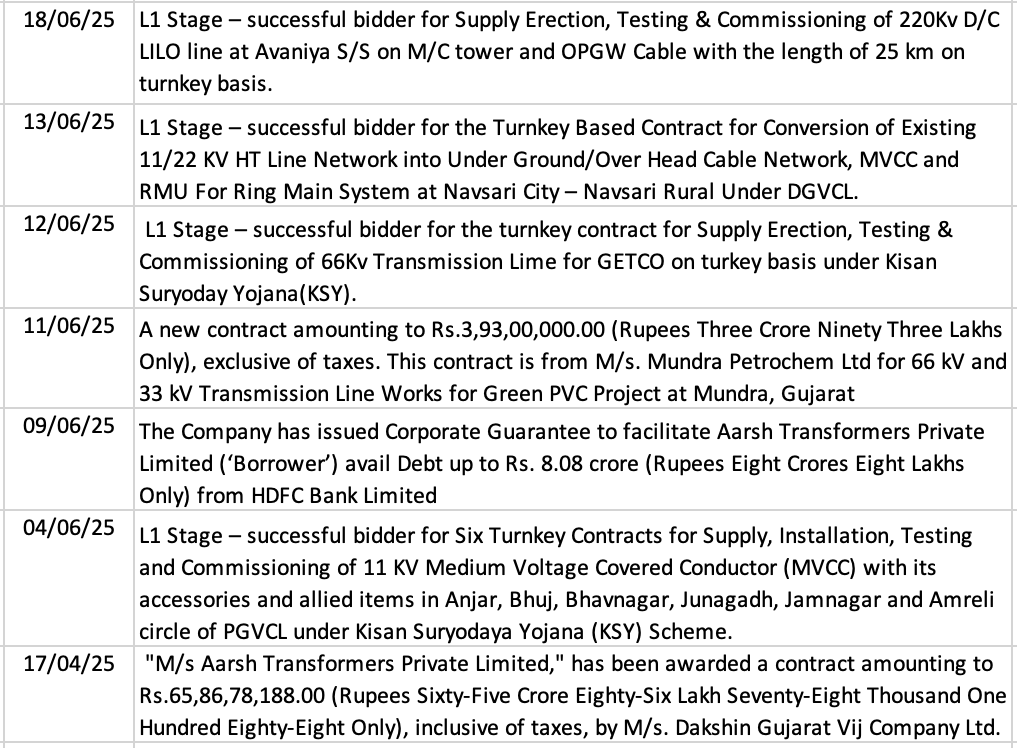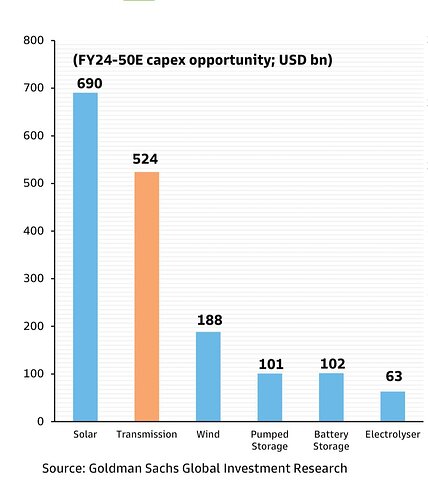Company Overview
Viviana Power Tech Ltd. is an integrated engineering, procurement, and construction (EPC) company specializing in power infrastructure. Established in 2014 and listed on the NSE Emerge platform in 2022, the company has rapidly grown into a notable player in India’s power sector. The company operates within the Capital Goods sector, with a specific focus on the Power Transmission & Distribution (T&D) Equipment and EPC subsector.
Business Model
Two key segments:
- Power EPC: This is the core business, providing turnkey services for power transmission and distribution. This includes the design, supply, erection, and commissioning of transmission lines and substations up to 400KV for government utilities and private clients, including major renewable energy developers.
- Transformers: Company has acquired 75% equity Shares of Aarsh Transformers Private Limited to carry out business of designing, manufacturing and assembling of Power and Distribution Transformers, Compact Substations, Ring Main Units, Electrical Panels, Electrical Components etc. used in Power Generation, Transmission and Distribution network and renewable energy system.
Financials
-
Income Statement:
Source -
Balance Sheet:
Source -
Cash Flows:
-
Working Capital:
Source -
Shareholding:
Source -
Efficiency Metrics:
Investment Rationale
Viviana is at the cusp of a significant growth phase, uniquely positioned to capitalize on India’s massive power generation and renewable energy ambitions.
-
Massive Industry Tailwinds: India’s commitment to adding 500 GW of renewable capacity by 2030 and strengthening its national grid under schemes like the Revamped Distribution Sector Scheme (RDSS) creates a multi-trillion-rupee opportunity. Viviana, as an established EPC player, is a direct beneficiary of this unprecedented capital expenditure cycle. The government’s infrastructure focus provides a long-term, structural growth driver for the entire sector.
-
Explosive Growth: The company has demonstrated phenomenal growth, with revenues surging 232% and profits growing 186% in FY25. This isn’t just growth; it’s profitable growth, evidenced by a strong ROCE (42%) and ROE (33.33%). The unexecuted order book stands at ₹1,000 Cr as on 20th August, 2025. Source: Link
Recent Order Wins:
Source: Link -
Expansion into Transformer Manufacturing: This backward integration strategy provides them with a captive market for their transformers while also opening up new revenue streams. Revenue potential >50cr.
-
Proven Execution & Marquee Clients: In the EPC business, execution is everything. Viviana has built a strong reputation by working with marquee clients like Adani Green Energy and Gujarat’s state power utilities.
-
Shift Towards Larger, Higher-Margin Projects: The company is strategically moving away from smaller projects and subcontracting roles to focus on larger turnkey projects, where they supply all materials and have greater control over margins. This shift is evident in the changing composition of their cost structure, with material costs now accounting for 75-80% of project costs.
-
Main Board Listing: Company’s plan to shift from SME platform to the main board (NSE) could unlock greater liquidity and attract institutional investors.
Industry & Macro Tailwinds
- Policy Support: The Revamped Distribution Sector Scheme (RDSS) , with an outlay of over ₹3 lakh crore, aims to improve the operational efficiency and financial sustainability of distribution companies (Discoms). Viviana has already won significant projects under this scheme, highlighting its ability to capitalize on these government programs.
- Sectoral Cycles: India’s per capita electricity consumption is still well below the global average. With a rising population, increasing urbanization, and the adoption of electric vehicles, the national power demand is projected to double in the next decade, ensuring a sustained, long-term demand for power infrastructure.
- Size Of Opportunity: The rapid adoption of Artificial Intelligence is emerging as a structural driver of global power demand. Training large AI models and running data centers at scale require massive computing power, which translates into significantly higher electricity consumption. Unlike traditional IT workloads, AI servers operate at much higher utilization rates and need round-the-clock energy reliability, creating a step-function rise in demand rather than a gradual increase. As hyperscalers and enterprises accelerate investments in AI infrastructure, utilities and grid operators worldwide are already warning of supply pressures, with forecasts suggesting that data centers could consume double their current share of electricity within this decade. For India, where data center capacity is projected to grow rapidly, this trend represents a long-term tailwind for the power sector and its enablers.
Jensen Huang (Nvidia CEO): “Every single data center in the future will be power limited…We are now a power limited industry.” Source: Link
Sam Altman (OpenAI CEO): “Eventually, the cost of AI will converge to the cost of energy.”. Source: Link
Competitive Advantage
-
Management Expertise: The promoters bring deep domain knowledge to the table. Chairman & MD Mr. Nikesh Choksi has 39 years of experience, while his son, Whole-Time Director Mr. Richi Choksi, has 13 years in the power infrastructure industry.
-
Gujarat Energy Transmission Corporation (Getco) is set to invest Rs 1 lakh crore over the next eight to 10 years to build additional transmission infrastructure Source. Viviana is a prominent player in Gujarat and promoter Mr. Nikesh Choksi is ex-Getco with 21+ years of association with them. The dots are there to be connected.
Governance
-
Related Party Transactions: The company engages in RPTs, primarily for office rent and services purchased from entities connected to the promoters. While these are approved by the board and disclosed, can be further monitored and evaluated.
-
[Minor] The Secretarial Audit for FY24 noted delays in certain regulatory filings, such as XBRL format submissions and insider trading disclosures.
Risks
- Lack of Moat: EPC companies often struggle to build durable moats because their business models are largely commoditized and project-based. Contracts are typically awarded through competitive bidding, where the lowest cost often wins, leaving little room for differentiation beyond execution track record. Margins remain thin, pricing power is minimal, and customer loyalty is limited since clients can easily switch to rival contractors. Unlike product companies or utilities, EPC players rarely benefit from scale-driven barriers, intellectual property, or strong brand stickiness—making them highly vulnerable to cyclicality and competitive intensity.
- Client Concentration: A significant portion of revenue comes from a few large clients (Getco, Adani). Any delay or cancellation of projects from a key client could have a material impact.
- Transformers Oversupply: According to concalls of multiple transformer players in India, the industry is likely to enter an oversupply phase by FY28, suggesting that new entrants may be late to the transformer party.
- Risk of Project Delays: The company learned valuable lessons from past experiences with project delays in transmission line projects, particularly those involving right-of-way issues. They are now focusing on projects where right-of-way is the client’s responsibility, minimising the risk of delays and cost overruns.
- Dependence on Government Spending: Viviana Power Tech’s growth is heavily reliant on government spending in the power distribution sector. Any significant changes in government policy or funding priorities could impact their business outlook.
Disclaimer: Invested




















